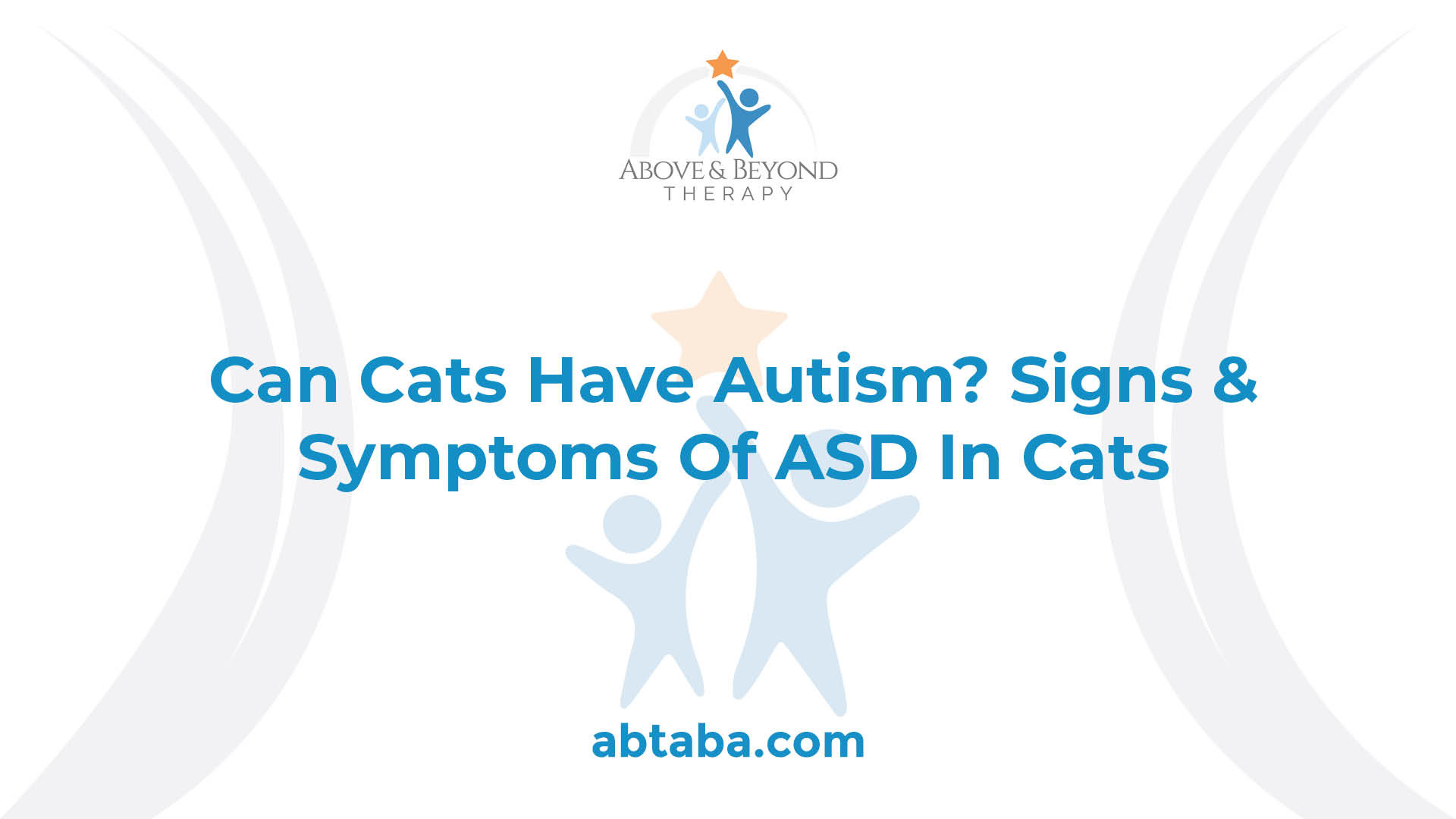Do Cats Have Autism? The answer is complex, but at solcat.net, we can help you understand feline behavior and explore the possibilities of Autism Spectrum Disorder (ASD) in cats. It’s important to differentiate between quirky cat behaviors and potential autism-like traits, so let’s examine this complex subject together. Discover the potential for feline neurodiversity with behavior and care tips and expert advice.
1. What Is Autism Spectrum Disorder (ASD) and Can Cats Have It?
Autism Spectrum Disorder (ASD) is a neurodevelopmental condition affecting social interaction, communication, and behavior. ASD is diagnosed in humans, and interest has increased in the possibility of similar neurodiversity in animals, including cats.
Currently, there’s no definitive scientific evidence that cats have autism in the same way humans do. According to research from the Cornell Feline Health Center, in July 2025, specific diagnostic criteria for feline autism do not exist, making diagnosis difficult. Despite this, some cats show behaviors resembling those seen in humans with ASD, prompting further investigation into feline behavior.
2. What are the Potential Signs and Symptoms of Autism in Cats?
Identifying autism in cats is challenging, as their behaviors can vary widely. While a definitive diagnosis isn’t possible, certain behaviors may suggest autism-like traits.
Here’s a breakdown:
| Behavior | Description |
|---|---|
| Stereotypic Behaviors | Repetitive actions like pacing, tail-chasing, or excessive grooming. |
| Sensory Sensitivities | Heightened reactions to noises, movements, or changes in environment, leading to anxiety or avoidance. |
| Social Challenges | Difficulty forming bonds, preferring solitude, unusual communication like avoiding eye contact. |
| Rigid Routine & Sensitivity | Strong preference for routine. Changes in environment or schedule cause distress. |
It is important to consult with a vet before jumping to conclusions. These signs alone don’t confirm autism in cats and could indicate other behavioral or medical issues.
 A cat exhibiting repetitive paw-licking behavior
A cat exhibiting repetitive paw-licking behavior
3. What Factors Influence Feline Behavior and Autism-Like Traits?
Several factors influence cat behavior, making it challenging to pinpoint a single cause for autism-like traits.
3.1. Genetics and Heredity
Genetics play a role in shaping cat behavior. According to the American Animal Hospital Association (AAHA), genetic variations may contribute to behavioral differences. However, no specific genes for autism in cats have been identified.
3.2. Environmental Factors
A cat’s environment significantly impacts its behavior. Factors include living conditions, social interactions, experiences, and stress levels. A stimulating environment promotes positive behavior, while stressful experiences can lead to behavioral challenges.
3.3. Socialization and Early Development
Proper socialization during the critical period of 2-7 weeks is crucial. Positive interactions with humans, littermates, and other animals help develop social skills. Lack of socialization may contribute to behavioral issues.
4. When Should You Seek Professional Advice About Your Cat’s Behavior?
If you observe unusual behavior or suspect your cat has autism-like traits, seek professional advice. Veterinarians or animal behaviorists specializing in feline behavior can provide valuable guidance.
4.1. Consulting with a Veterinarian or Animal Behaviorist
A veterinarian or animal behaviorist can assess your cat’s behavior, medical history, and environment. They can rule out underlying medical conditions and provide tailored recommendations.
4.2. Diagnostic Process for Feline Autism-Like Traits
Diagnosing autism-like traits in cats involves a comprehensive behavioral assessment. This includes observing social interactions, communication, repetitive behaviors, and sensory sensitivities. The goal is to understand the full scope of their behavior, and that’s when solcat.net can come into play to help you find the right specialists.
4.3. Management and Support Strategies for Cats with Autism-Like Traits
Management strategies for cats with autism-like traits may include creating a structured environment, establishing predictable routines, and using behavior modification techniques. Environmental enrichments, like interactive toys, can reduce stress and anxiety.
5. Understanding Feline Neurodiversity
Feline neurodiversity acknowledges that cats, like humans, exhibit variations in brain development, affecting their behaviors and interactions. Understanding neurodiversity is essential to providing the best possible care for our feline companions.
6. Promoting Positive Interactions with Your Cat
Creating a supportive environment can promote positive interactions with your cat. Provide a consistent routine, offer plenty of toys and enrichment, and learn to recognize their body language.
7. How Can Owners Create a Safe and Comfortable Environment for Cats with Sensory Sensitivities?
Creating a safe and comfortable environment for cats with sensory sensitivities is essential for their well-being.
7.1. Minimize Loud Noises and Sudden Movements
Loud noises and sudden movements can be overwhelming for cats with sensory sensitivities. According to the American Animal Hospital Association (AAHA), providing a quiet and predictable environment can help reduce stress.
7.2. Provide Soft and Comfortable Bedding
Cats with sensory issues often appreciate soft and comfortable bedding. Offer a variety of options, such as plush beds or cozy blankets, to allow your cat to choose their preferred resting spot.
7.3. Offer Safe Hiding Places
Providing safe hiding places is crucial for cats with sensory sensitivities. Cardboard boxes, cat tunnels, and covered beds can offer a sense of security and allow your cat to retreat when feeling overwhelmed.
7.4. Use Calming Pheromone Diffusers
Calming pheromone diffusers can help create a more relaxed environment for cats with sensory issues. These diffusers release synthetic feline pheromones that mimic the natural pheromones produced by cats, promoting a sense of calm and security.
7.5. Introduce Changes Gradually
Sudden changes in the environment can be stressful for cats with sensory sensitivities. Introduce changes gradually, allowing your cat time to adjust to new sights, sounds, and smells.
7.6. Avoid Strong Scents and Chemicals
Strong scents and chemicals can be irritating for cats with sensory sensitivities. Avoid using heavily scented cleaning products, air fresheners, and perfumes around your cat, and opt for fragrance-free alternatives.
7.7. Provide Predictable Routines
Predictable routines can help reduce anxiety and stress in cats with sensory sensitivities. Establish a consistent feeding schedule, playtime routine, and bedtime routine to provide a sense of security and predictability.
By minimizing loud noises, providing soft bedding, offering safe hiding places, using calming pheromone diffusers, introducing changes gradually, avoiding strong scents, and providing predictable routines, you can create a safe and comfortable environment for cats with sensory sensitivities.
8. How Can Owners Manage Repetitive Behaviors in Cats with Autism-Like Traits?
Managing repetitive behaviors in cats with autism-like traits requires patience, understanding, and a tailored approach.
8.1. Identify Triggers
Identifying the triggers for repetitive behaviors can help owners proactively manage and minimize these behaviors. Pay attention to environmental factors, social interactions, and daily routines that may precede or exacerbate repetitive behaviors in your cat.
8.2. Provide Environmental Enrichment
Environmental enrichment can help redirect your cat’s focus away from repetitive behaviors and provide alternative outlets for their energy. Offer a variety of toys, scratching posts, and interactive feeders to stimulate your cat’s mind and body.
8.3. Redirect Attention
When you notice your cat engaging in repetitive behaviors, try to redirect their attention to a different activity. Use toys, treats, or gentle petting to engage your cat and interrupt the repetitive behavior pattern.
8.4. Establish Predictable Routines
Predictable routines can help reduce anxiety and stress in cats with autism-like traits, which in turn can minimize repetitive behaviors. Establish consistent feeding schedules, playtime routines, and rest periods to provide a sense of security and predictability.
8.5. Consult with a Veterinarian or Animal Behaviorist
If repetitive behaviors are severe or interfere with your cat’s quality of life, consult with a veterinarian or animal behaviorist. They can help assess your cat’s behavior and develop a tailored management plan to address repetitive behaviors.
By identifying triggers, providing environmental enrichment, redirecting attention, establishing predictable routines, and consulting with a professional, owners can effectively manage repetitive behaviors in cats with autism-like traits and improve their overall well-being.
9. What Are the Benefits of Early Intervention for Cats Exhibiting Autism-Like Traits?
Early intervention can significantly benefit cats exhibiting autism-like traits by improving their quality of life and promoting positive behavioral outcomes.
9.1. Improved Social Skills
Early intervention can help cats with autism-like traits develop better social skills and form stronger bonds with their human companions. Socialization programs and positive reinforcement techniques can help cats learn appropriate social behaviors and reduce social anxiety.
9.2. Reduced Anxiety and Stress
Early intervention can help reduce anxiety and stress in cats with autism-like traits by providing a structured and predictable environment. Consistent routines, safe hiding places, and calming pheromone diffusers can help create a sense of security and stability.
9.3. Enhanced Cognitive Function
Early intervention can help enhance cognitive function in cats with autism-like traits by providing stimulating activities and enrichment opportunities. Interactive toys, puzzle feeders, and training exercises can help improve focus, problem-solving skills, and overall cognitive abilities.
9.4. Better Behavioral Outcomes
Early intervention can lead to better behavioral outcomes in cats with autism-like traits by addressing behavioral issues early on. Behavior modification techniques, such as counterconditioning and desensitization, can help reduce unwanted behaviors and promote more positive behaviors.
9.5. Improved Quality of Life
Ultimately, early intervention can improve the overall quality of life for cats with autism-like traits by reducing stress, anxiety, and behavioral challenges. With appropriate support and management, cats can live happy, fulfilling lives.
By providing early intervention, owners can help cats with autism-like traits thrive and reach their full potential.
10. What Are Some Common Misconceptions About Autism in Cats?
Several misconceptions surround the topic of autism in cats, leading to confusion and misinformation.
10.1. Autism in Cats Is the Same as Autism in Humans
One common misconception is that autism in cats is the same as autism in humans. While cats may exhibit behaviors similar to those seen in individuals with autism, it’s important to recognize that feline behavior is influenced by a variety of factors.
10.2. All Cats with Unusual Behaviors Have Autism
Another misconception is that all cats with unusual behaviors have autism. Many factors can influence cat behavior.
10.3. Autism in Cats Is a Death Sentence
Autism is not a death sentence. With proper management and support, cats can live happy and fulfilling lives.
10.4. Owners Are to Blame for Their Cat’s Autism
Owners are not to blame for their cat’s autism. Factors, such as genetics and early socialization, play a role in shaping behavior.
10.5. There Is a Cure for Autism in Cats
Currently, there is no cure for autism in cats. Management and support strategies can help improve their quality of life.
FAQ: Understanding Autism in Cats
Here are some frequently asked questions about autism in cats, providing clear and concise answers.
- Can cats have autism?
While cats can exhibit autism-like traits, there’s no definitive scientific evidence they experience autism the same way humans do. - What are the signs of autism in cats?
Signs may include repetitive behaviors, sensory sensitivities, social challenges, and a strong preference for routine. - How is autism diagnosed in cats?
A veterinarian or animal behaviorist conducts a comprehensive behavioral assessment to evaluate behavior and rule out other medical conditions. - What causes autism-like traits in cats?
Factors such as genetics, environment, and early socialization can influence a cat’s behavior. - Can owners manage autism-like traits in cats?
Owners can manage autism-like traits through environmental enrichment, predictable routines, behavior modification techniques, and professional guidance. - Are there any medications for autism in cats?
There are no medications specifically for autism in cats. Medications may be prescribed to address specific symptoms. - How can owners create a supportive environment for cats with autism-like traits?
Owners can create a supportive environment by providing safe hiding places, minimizing loud noises, establishing predictable routines, and offering plenty of love and attention. - What is the prognosis for cats with autism-like traits?
With appropriate management and support, cats can live happy, fulfilling lives. - Should owners consult a veterinarian about their cat’s behavior?
Owners should consult a veterinarian or animal behaviorist if they have concerns about their cat’s behavior. - Where can owners find more information about autism in cats?
Owners can find more information about autism in cats from trusted sources such as solcat.net.
At solcat.net, we are dedicated to providing reliable and up-to-date information about feline behavior and well-being. Whether you’re seeking expert advice, helpful resources, or a supportive community, we’re here to help you navigate the complexities of cat ownership and ensure a happy, healthy life for your furry friend. Visit our website today to discover a wealth of articles, guides, and community forums, where you can connect with fellow cat lovers, share your experiences, and learn valuable insights into understanding and caring for your feline companion. Solcat.net is your go-to destination for all things cat-related, offering guidance, support, and a passion for enhancing the lives of cats and their owners.
Address: 950 Alaskan Way, Seattle, WA 98104, United States.
Phone: +1 (206) 386-4000
Website: solcat.net.
Conclusion: Embracing Feline Neurodiversity
While the concept of autism in cats remains a topic of ongoing research, understanding feline neurodiversity is essential for providing the best possible care. By recognizing and embracing the unique behaviors of our feline companions, we can create supportive environments that promote their well-being. Remember, every cat is an individual, and with the right care and attention, they can thrive and enrich our lives. At solcat.net, we are committed to providing you with the resources and information you need to understand and support your feline friend.


